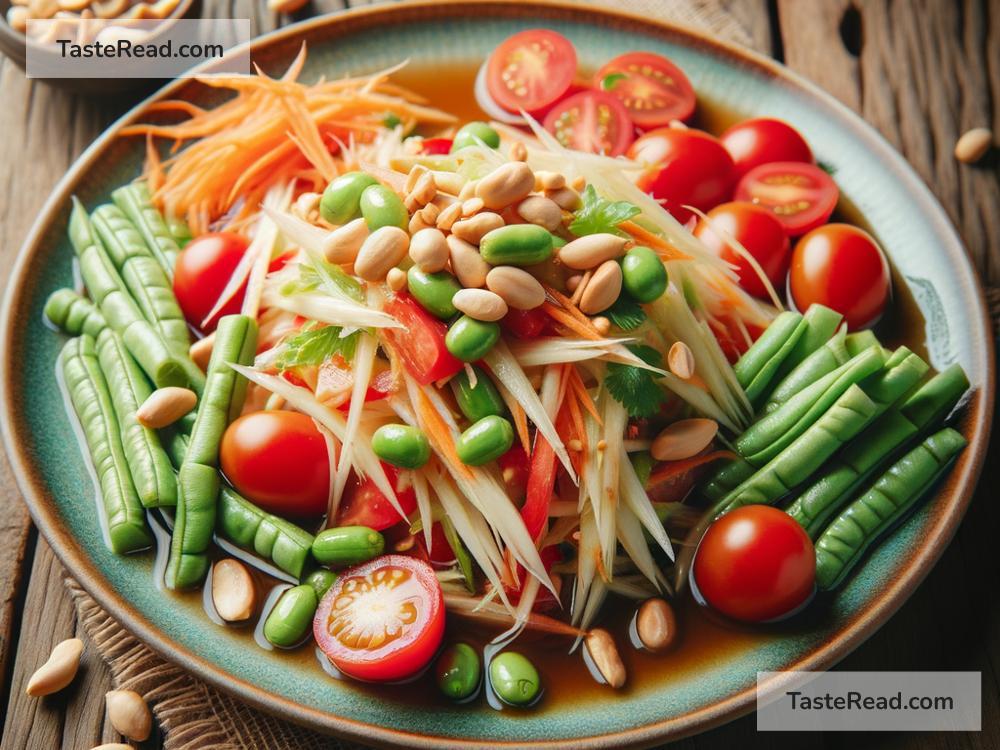Discovering the Roots of the Thai Som Tum Salad
Imagine walking down the bustling streets of Thailand, your senses dancing with the sights, sounds, and smells. Among these captivating experiences, one dish stands out for its crunchy texture, tangy flavors, and spicy kick: the iconic Som Tum Salad. This delightful dish, also known as Thai Papaya Salad, has a fascinating story that stretches back into Thailand’s rich history.
Som Tum is a spicy salad made from shredded green papaya. It’s a blend of sweet, sour, salty, and spicy flavors that embodies the essence of Thai cuisine. But how did this simple salad become a culinary icon in Thailand and beyond? Let’s delve into the roots of Som Tum Salad and discover its journey from humble beginnings to international fame.
Origins in Laos and Influence from Cambodia
The story of Som Tum begins in Southeast Asia, specifically in Laos and Cambodia, where it is believed to have its origins. The dish closely resembles the Cambodian “bok l’hong,” suggesting a shared culinary history. As people traveled and cultures mixed, the salad found its way into Thailand, where it was embraced and adapted to become the Som Tum we know today.
The Salad Migrates to Thailand
Som Tum’s arrival in Thailand marked the beginning of a new chapter in its history. Thailand’s version took the basic ingredients and added its unique twist, incorporating local herbs and spices that added depth and complexity to the dish. As it traveled from northeastern Thailand (Isan region) to other parts of the country, variations emerged, reflecting the diverse culinary landscape of Thailand.
Ingredients of Som Tum Salad
At its core, Som Tum Salad consists of shredded green papaya, which gives it a crunchy texture. To this, a variety of other ingredients are added, including tomatoes, beans, peanuts, dried shrimp, garlic, lime, fish sauce, and, most importantly, chili peppers, which provide its signature heat. The ingredients are pounded together in a mortar, melding their flavors into a perfect balance of spicy, sour, salty, and sweet sensations.
Variations Across Thailand
As Som Tum spread across Thailand, several regional variations developed. The classic version is known as “Som Tum Thai,” which includes peanuts and dried shrimp. “Som Tum Pu Pla Ra” from the northeastern region includes fermented fish sauce and crab, offering a stronger flavor. There’s even a “Som Tum Polamai,” a fruit version that incorporates a mix of seasonal fruits for a sweeter take on the classic salad.
A Cultural Staple
Som Tum is more than just a salad; it’s a staple of Thai culture and cuisine. It’s commonly found in street food stalls, local eateries, and fine dining restaurants across Thailand, making it accessible to everyone. The dish is especially popular during the hot summer months, as its spicy and sour profile offers a refreshing respite from the heat.
International Recognition
The global spread of Thai cuisine has brought Som Tum to the international stage, where it has been embraced by food lovers around the world. Today, it’s not uncommon to find Som Tum being served in Thai restaurants worldwide, introducing people to the flavors of Thailand. Its popularity has also sparked interest in Thai cooking, with many aspiring chefs and food enthusiasts seeking to learn how to create this iconic dish at home.
The Legacy of Som Tum
The history of the Thai Som Tum Salad is a testament to the power of culinary evolution and cultural exchange. From its origins in the neighboring countries of Laos and Cambodia to its beloved status in Thailand and recognition on the global culinary scene, Som Tum has traversed a remarkable journey. This simple yet sophisticated dish reflects the depth and diversity of Thai cuisine, captivating the hearts and taste buds of people everywhere.
In exploring the history of the Thai Som Tum Salad, we discover not just the origins of a dish but the story of a region’s culinary traditions and the ways in which food can bring people together. Whether enjoyed in the bustling streets of Bangkok, a cozy restaurant abroad, or in the comfort of your own home, Som Tum remains a delightful celebration of Thai culture, history, and the universal joy of good food.


